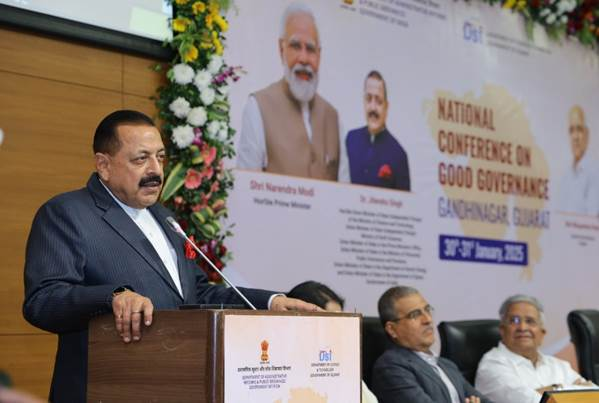Dr. Jitendra Singh Lauds Gujarat’s Governance Model at National Conference, Calls for Replication Across India
A key component of the shift in governance culture under Prime Minister Modi’s leadership, Dr. Singh explained, is the move to decentralize policy discussions and outreach programs.

- Country:
- India
Union Minister Dr. Jitendra Singh emphasized the "Gujarat Governance Model" as a powerful template for effective governance at the National Conference on Good Governance held in Gandhinagar, Gujarat. Speaking to a diverse audience of policymakers, senior bureaucrats, and governance experts, Dr. Singh highlighted several innovations introduced under Prime Minister Narendra Modi’s leadership as Chief Minister of Gujarat, many of which have since been replicated across the nation.
Decade of Governance Transformation
In his keynote address, Dr. Singh celebrated the remarkable transformation in Indian governance over the last decade. He noted that many national-level reforms had been initially tested and perfected in Gujarat, which served as the crucible for ideas later implemented nationwide. "This transformation did not happen overnight. The policies we see today at the national level were first implemented and refined in Gujarat," he said.
Decentralizing Governance for Inclusivity
A key component of the shift in governance culture under Prime Minister Modi’s leadership, Dr. Singh explained, is the move to decentralize policy discussions and outreach programs. "Governance is no longer confined to the traditional administrative stronghold of Delhi," Dr. Singh observed. "By holding major conferences and discussions in various parts of the country, we ensure that the reforms are more inclusive and reflective of the aspirations of the people from every corner of India."
Historical Reforms: From Bureaucracy to Innovation
Dr. Singh also recalled Sardar Patel’s vision of a "steel frame" bureaucracy, which the Modi government has further enhanced through the philosophy of 'Maximum Governance, Minimum Government.' He pointed to several landmark reforms, such as the scrapping of nearly 2,000 obsolete laws, eliminating the requirement for attested documents, and removing interviews for junior government jobs as measures that have streamlined bureaucracy and made it more transparent.
One of the key examples he cited was Gujarat’s pioneering 24-hour rural electrification scheme, which was rolled out in the early 2000s. At the time, electricity supply was erratic in many parts of the country, but Gujarat set an example by providing uninterrupted power in rural areas. "This model of rural electrification was later scaled up nationwide," Dr. Singh noted, marking a significant shift in governance priorities that benefited millions of rural households across India.
Digital Governance: A National Leap
The Minister also touched on India’s success in the realm of digital governance. He highlighted the significant role of technology in public administration, with innovations such as online RTI applications, digital life certificates for pensioners using facial recognition, and AI-driven decision-making transforming governance. He stated that these efforts position India as a leader in governance innovation.
One such breakthrough, CPGRAMS (Centralized Public Grievance Redress and Monitoring System), is seen as a global model for citizen-centric governance. Dr. Singh spoke of CPGRAMS 7.0, an AI-enhanced system that incorporates semantic search and predictive analytics, boosting the government’s responsiveness to public grievances. The platform has seen remarkable results, with over 19 lakh feedbacks collected and a 50% rise in satisfaction levels.
E-Governance and Transparency: The Shift to Paperless Administration
Further, Dr. Singh highlighted the transformation that has taken place in the sphere of e-governance, including the implementation of e-Office 7.0, which has enabled paperless administration across all ministries. "This move has greatly increased efficiency, transparency, and accountability in government operations," he said.
In line with India’s e-governance push, platforms like the National Conference on e-Governance (NCeG) have helped foster collaboration between the Central Government and States since 1997, further strengthening the country’s governance framework.
Sushasan Saptah and Citizens First
Dr. Singh also lauded the success of the fourth Sushasan Saptah—Good Governance Week (December 19–25, 2024). This initiative, aligned with Prime Minister Modi's vision of next-generation reforms, saw 36,000 camps organized across 700+ districts, resolving nearly 2.89 crore service applications. "This is a testament to the government’s commitment to bringing governance closer to the citizens through streamlined procedures and technology-driven service delivery," he said.
The Path Ahead: Collaborative Governance and Innovation
In his concluding remarks, Dr. Singh reiterated the importance of continued collaboration between the Central and State Governments to implement effective reforms and drive India towards becoming a global model for effective governance. He praised Gujarat’s governance for setting a benchmark in administrative efficiency and urged other states to adopt similar models to enhance service delivery and public administration.
The conference also featured a special address by Shri V. Srinivas, Secretary, DAR&PG, who hailed the event as a significant milestone in realizing the Prime Minister’s vision of leveraging Artificial Intelligence and emerging technologies to improve governance.
As the conference concluded, Dr. Jitendra Singh expressed confidence that India’s commitment to innovation, transparency, and technology-driven governance will serve as a global example, with ongoing reforms enhancing the citizen-government relationship and ensuring that the country’s governance systems are responsive, efficient, and inclusive.
- READ MORE ON:
- Dr. Jitendra Singh
- Gujarat Governance Model










